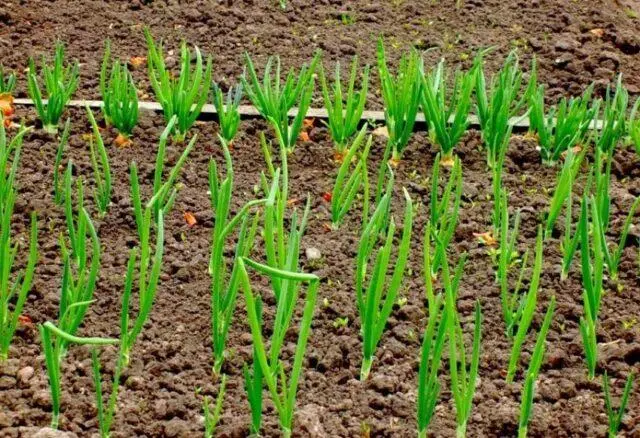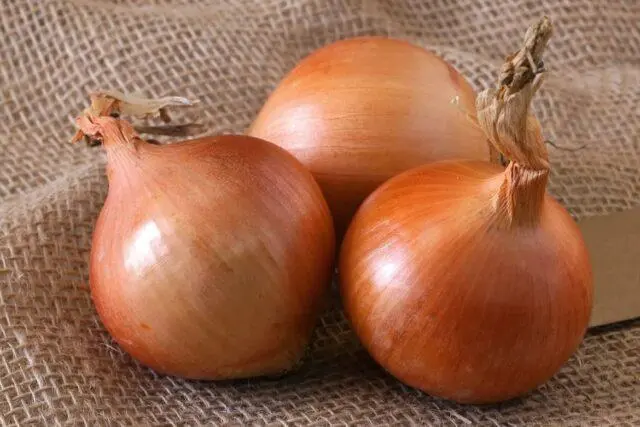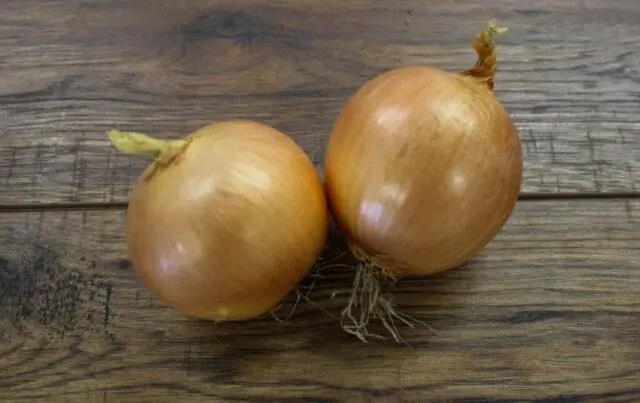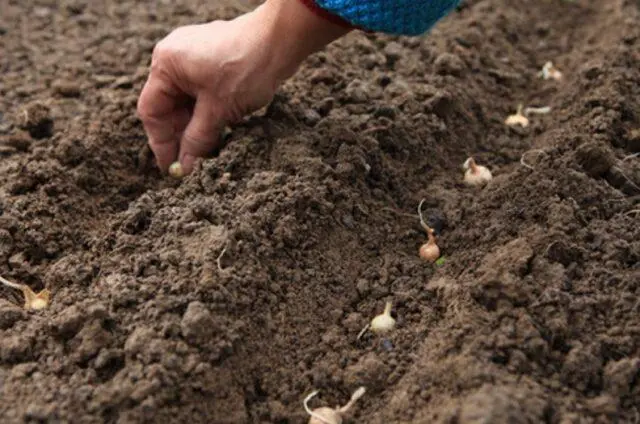Contents
Onion Chalcedony is a well-known early ripe variety that yields a crop 3,5–4 months after planting. Grow on turnip, sevok and greens. Onions Chalcedony can be cultivated in a one-year and two-year cycle. The culture is resistant to drought and frost, so it can be grown in different regions of Our Country.
Origin of the variety
Onion Chalcedony was bred on the basis of the Pridnestrovian Research Institute of Agriculture in the late 80s of the XX century. breeders Khaisin M.F. and Vasilyeva Z.I. The variety was tested and included in the register of breeding achievements of the Federation in 1993. The originators of the variety are the Sortsemovoshch companies (Stavropol Territory) and Agrofirm Poisk (Moscow Region).
Description and characteristics of the onion variety Chalcedon
Chalcedony onions are distinguished by good yield, immunity to diseases and resistance to adverse weather conditions. The culture withstands frosts and germinates even at 3-5 degrees Celsius. Tolerates short periods of drought.
Appearance
Onion Chalcedony has a regular rounded shape. The peel is smooth, light brown in color, dry. The bulbs are large, up to 15 cm in diameter (weight 120–150 g), greens up to 16 cm high. The feathers have a hollow structure, while the walls are soft, juicy, and the thickness is medium. The color is typical bright green.
Ripening time and yield

Onion Chalcedony is an early ripe variety: the first harvest can be harvested already 110-120 days after germination
Subject to agricultural technology, the yield is 7–8 kg per square meter. In industrial cultivation, the indicator reaches from 200 to 630 c/ha, which is significantly higher than a number of varieties (for example, Moldavsky, Strigunovsky local).
The commodity yield on the eve of harvesting is 98%, after ripening in the warehouse, in storage – 100%. Chalcedony onions are suitable for long-term storage (up to 7–8 months) under appropriate conditions: temperature 2–5 degrees, humidity up to 70%, blackout. Bulbs are dense, they can be transported over long distances.

Onion Chalcedony has the correct shape and large size
Disease and pest resistance
The culture is characterized by high resistance to common diseases and pests. However, if the rules of care are violated (excessive watering, growing on depleted, dense soil), it is affected by neck rotting (it affects the root crop almost completely) and peronosporosis (downy mildew).
May also be affected by some insects and worms:
- onion moth, onion fly;
- stem nematode.
Therefore, when growing, timely measures of prevention and treatment are required – in this case, you can harvest the maximum yield.
Composition and Properties
The composition of the Chalcedony onion pulp contains water (82%) and dry matter (18% in total):
- sugar (maltose, sucrose, inulin);
- proteins (including enzymes);
- organic acids (ascorbic, malic, citric);
- pectin;
- glycosides;
- saponins;
- flavonoids;
- phytoncides;
- potassium;
- iron;
- phosphorus;
- sulfur;
- iodine and other trace elements;
The taste of onion Chalcedony is sharp, with sweetish notes and moderate bitterness. The pulp is white, juicy, dense.
Application
The main use of Chalcedony onions is turnip (annual cultivation from seeds). Vegetables are used for all kinds of dishes and preparations. You can grow Chalcedony onions on a feather. Moreover, it is sown not only in spring, but also in autumn (in a heated room, greenhouse) to get greenery in winter. The culture is allowed to be cultivated both for personal consumption and for sale.
Growing regions
Onion Chalcedony is officially approved for cultivation in the regions of the North Caucasus, Kuban, as well as in the Lower Volga region. Culture can be cultivated in other regions of Central Our Country, including in the middle lane and the Moscow region. Gardeners grow Chalcedony onions in neighboring countries as well. It can be found in Belarus and Ukraine.
Advantages and disadvantages
Onion Chalcedony is easy to care for and quite productive. In addition, it has a good taste and is stored for more than six months. Thanks to these and other advantages, the culture is popular with summer residents and farmers.

Onion Chalcedony can be grown in different regions of Our Country
Pros:
- good yield;
- excellent taste;
- high commodity output;
- bulbs are large, attractive in appearance;
- can be planted both in spring and autumn (before winter);
- the variety is resistant to most diseases and pests;
- stored up to eight months;
- transportable.
Cons:
- prone to peronosporosis, neck rot;
- for lovers of miniature bulbs, Chalcedony onions are not suitable.
Terms of planting
Planting time depends on the method of cultivation and the climatic features of the region:
- seeds are planted for seedlings from the end of February to the first decade of March;
- seedlings are transferred to open ground in the second or third decade of April;
- seeds are sown in open ground in the first half of April;
- sowing in open ground is placed at the end of March.
How to plant Chalcedony onions
Onion Chalcedony is a versatile crop that can be cultivated in the following ways:
- Seeds for seedlings – for greens and onions (annual crop).
- Sevok in open ground – for greens and large bulbs (annual crop).
- Seeds and sets in open ground in a two-year cycle – to obtain feathers and root crops.
- Seeds in a heated greenhouse in autumn (as an annual) – for forcing greenery in the winter months.
Growing seedlings from seeds
Seeds are bought from trusted suppliers and seedlings are grown at home. The soil can be prepared in advance, for example, turf land with black peat, humus and sand in a ratio of 2: 1: 1: 1, or buy a mixture in a store. Sow from the end of February to mid-March in such a way as to transfer the seedlings to the garden 1,5 months after germination.

Seeds for seedlings are sown in early spring
When planting onions, Chalcedony acts in this way:
- Soak the seed in a weak solution of potassium permanganate for half an hour.
- Place in a bowl of warm water.
- Allow to dry and treat with “Epin” or other growth stimulant.
- Wrapped in damp gauze, placed on a flat dish, watered periodically and allowed to germinate within a week.
- Transplanted into pots (3-4 seeds each) to a shallow depth (up to 5 mm).
- Moisten the soil, cover the container with a film and grow at a temperature of 23-25 degrees.
- As soon as shoots appear, the film is removed, and the temperature is lowered to 16–18 degrees, if necessary, illuminated with a lamp.
- For two weeks until transplanting, harden at a temperature of 8-12 degrees.
- They are transplanted into open ground according to the scheme 25 * 25 cm.
Sowing seeds in open ground
With a two-year growing cycle, Chalcedony onion seeds can be planted immediately in open ground. Prepare them in the same way as in the case of seedlings. The beds for Chalcedony onions are formed in advance – they need to be dug up and fertilized, then several furrows are marked at least 3 cm deep with an interval of 20 cm. Sand is poured onto the bottom, then the seeds are distributed at a distance of 3 cm. Sprinkle with soil and give some water. At the end of August, the greens will turn yellow – small bulbs will begin to form. The sevok is harvested and stored until the next spring, and then sown in open ground, as described below.
Planting sevka in the spring
Growing onion Chalcedony sets is much easier because you do not need to work with seedlings. The instruction is as follows:
- Only dense, beautiful bulbs are selected.
- Warm up for 10 hours (temperature 40 degrees).
- Etch in a warm solution of any fungicide.
- Dry at room temperature, laying on the surface in one layer.
- Prepare the site in advance (clean, dig, fertilize).
- Make several furrows 3-4 cm deep at a distance of 25 cm.
- Onion sets of Chalcedony are placed bottoms down with an interval of 6–7 cm.
- Sprinkle with soil, water a little.

Sevoc is laid to a depth of no more than 4 cm
Is it possible to plant Chalcedony onions before winter
Gardeners plant Chalcedony onions before winter. Planting seeds begin from late October to the first half of November. You can grow it in a heated greenhouse or other room. The purpose of winter planting is to get fresh greenery throughout the winter and early spring.
Onion Care Chalcedony
Onion Chalcedony is undemanding to growing conditions. Basic cultivation rules:
- Watering is moderate – the top layer should have time to dry.
- Top dressing twice a season: organic or complex mineral fertilizer for young seedlings (feather height 8–10 cm), after three weeks they give potash fertilizer (30 g per 1 m2), superphosphate (40 g per 1 m2) and urea (20 g per 1 m2).
- The soil is periodically loosened, weeding is done.
Fighting diseases and pests
Fungal diseases, onion neck rot most often affect the culture against the background of excessive moisture. Therefore, the main measures of prevention and treatment are:
- planting in an open, sunny area;
- exclusion of location in the lowlands (preferably on a hill);
- compliance with the norm of watering;
- when signs of damage appear – treatment with Bordeaux mixture, “Fitosporin”, “Fundazol” or other fungicides.
Insects and other pests are fought with folk methods (decoction of marigold flowers, potato or tomato tops, infusion of mustard powder, laundry soap, tobacco dust, wood ash). Also use special insecticides:
- “Fufanon”;
- “Karate”;
- “Aktara”;
- “Fitoverm”;
- “Match”;
- “Vertimek” and others.
Conclusion
Chalcedony onion is one of the most stale and unpretentious varieties, which can be grown both in the middle lane, and in the Urals and Siberia. Gives consistently high yields even with normal care. It can be grown both on turnips and on greens, including for winter sowing.









